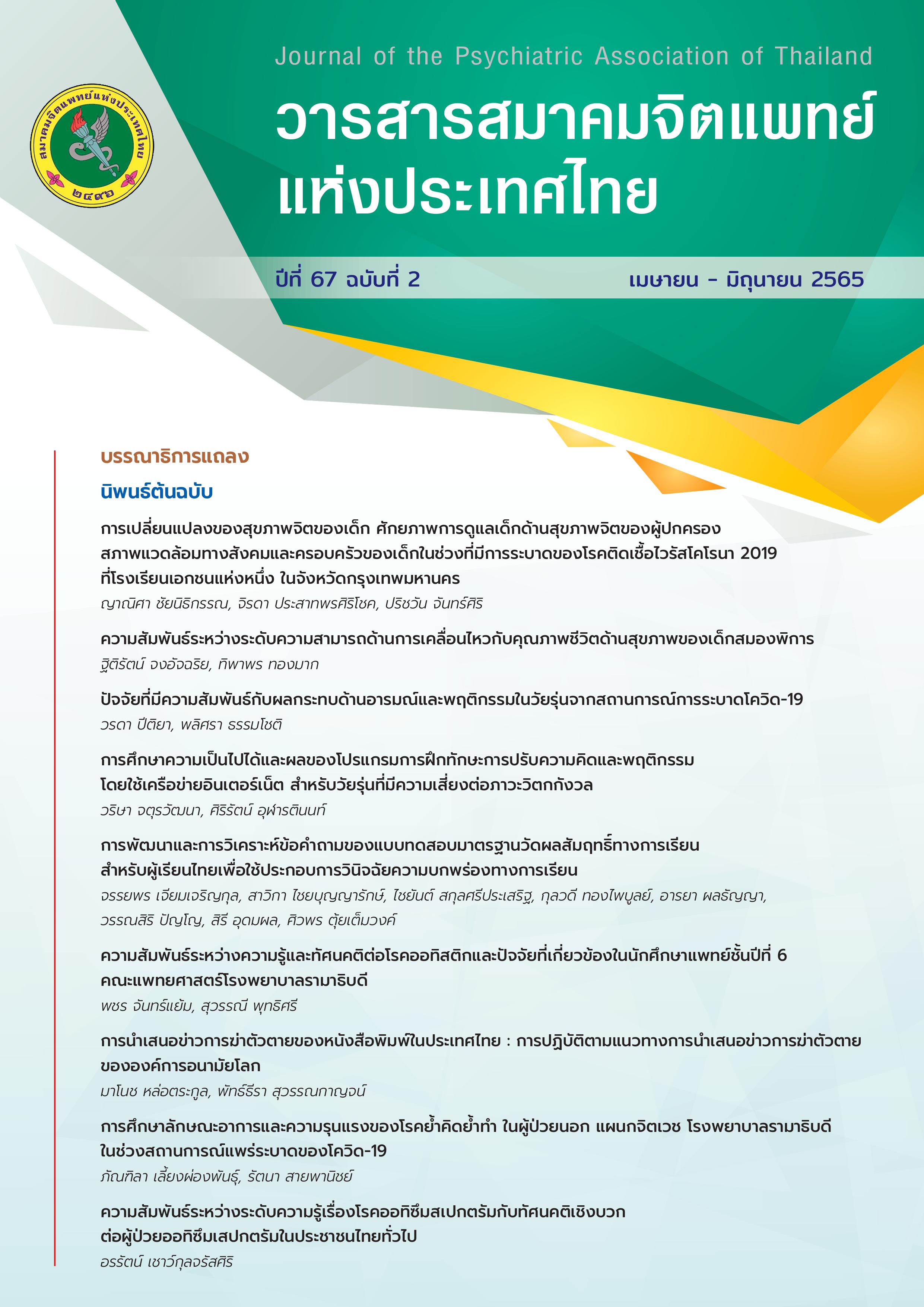The Development and Item Analysis of the Standardized Achievement Test for Thai Learners for Aiding in Diagnosing Learning Disorder
Main Article Content
Abstract
Objective: To develop the Standardized Achievement Test for Thai Learner (SAT) and to examine the psychometric properties of SAT, including content validation and item analysis.
Methods: The current study consisted of 2 phases. The first phase was the scale development process. The second phase was the try-out phase, with 375 Thai students, which investigated item difficulty and item discrimination.
Result: The SAT comprises 11 subtests; Letter Word Identification, Applied Problems, Spelling, Passage Comprehension, Calculation, Writing Sample, Word Attack, Oral Reading, Sentence Reading Fluency, Math Fact Fluency, and Sentence Writing Fluency. The content validation of the SAT was conducted by the expert panel. Additionally, it was found that the SAT had appropriate item difficulty and item discrimination.
Conclusion: The content validity, item difficulty and item discrimination of The SAT are supported. The norm of the SAT should be further developed.
Article Details

This work is licensed under a Creative Commons Attribution-NonCommercial-NoDerivatives 4.0 International License.
Articles submitted for consideration must not have been previously published or accepted for publication in any other journal, and must not be under review by any other journal.
References
Pornnoppadol C. Specific Learning Disorder; SLD. In: Sitdhiraksa N, Kamonnet W, Wannarit K, Pukrittakayamee P, Aptnuntavech S, Katumarn P, editors. Siriraj psychiatry DSM-5. 1st ed. Bangkok: Department of Psychiatry, Faculty of Medicine Siriraj Hospital;2558. p.509-16.
Roongpraiwan R. Prevalence and Clinical characteristics of dyslexia in primary school students. J Med Assoc Thai 2002;85(4):1097-103.
Piyasil V, Wangtan S. Learning Disorders and Comorbidity. J Psychiatr Assoc Thailand 2015;60(4):287-96.
Utairatanakit D, Pornnoppadol C, Rohitsuk W, et al. Potential development for students with autism, attention deficit hyperactivity disorder, and learning disorders: Phase 1: The development of standardized procedure and instrument for screening students with attention deficit hyperactivity disorder, learning disorders, and autism. In: Proceedings of 46th Kasetsart University Annual Conference: Education, Humanities and Social Sciences, Economics and Business Administration, Agricultural Extension and Home Economics. Bangkok (Thailand): The Thailand Research Fund; 2008. p. 64-71.
Utairatanakit D, Srisukwattananan P, Thiamtham T, et al. Kasetsart Basic Academic Skill Test (KBAST). Bangkok (Thailand): “Khun Poom” Special Education Development Study Center, Faculty of Education, Kasetsart University; 2015.
Piyasil V. Specific Learning Disorder (SLD) [Internet]. 2019 Oct [cited 2019 Jun 15]. Available from: http://110.164.147.155/kmhealth_new/Documment/psychiatry/children/P.1.1.3.pdf
Sayawaranon P. The study of Academic Achievement in elementary school students. Thai Journal of Clinical Psychology 1997;28(2):24-37.
Sathirangkul V, Sainampran D, Sirisakpanit S. Open view of WRAT-Thai. Thai Journal of Clinical Psychology. 2013;44(1):1-17.
Embretson SE, Reise SP. Item response for psychologists. 1st ed. Mahwah, NJ: Erlbaum; 2000.
Alfonso VC, Flanagan DP. Assessment of preschool children: A framework for evaluating the adequacy of the technical characteristics of norm-referenced instruments. In: Mowder BA, Rubinson F, Yasik A, Editors. Evidence-Based Practice in Infant and Early Childhood Psychology. 1st ed. New York, NY: John Wiley; 2008. p. 129-66.
McGrew KS. CHC theory and the Human Cognitive Abilities Project: Standing on the shoulders of the giants of psychometric intelligence research. Intelligence 2009; 37:1-10.
Flanagan DP, Alfonso VC, Ortiz S. The cross-battery assessment (XBA) approach: An overview, historical perspective, and current
directions. In: Flanagan DP, McDonough EM, Editors. Contemporary intellectual assessment: Theories, tests, and issues. 4th ed. New York, The Guilford Press; 2012. p. 459-83.
The Ministry of Education. Basic Education Core Curriculum B.E. 2551 (A.D.2008). Bangkok; 2008.
Thassana S. A Study of Arrangement Form of Thai Alphabets Simple for Writing Practices of Prathom Suksa One Students. Bangkok: Chulalongkorn University; 1986.
Punyasvasti P. Strokes for beginning Thai alphabet writing. Bangkok: Chulalongkorn University; 1971.
Aekkawut U. Basic Thai Words in Grade1-6 [Internet]. 2020 Oct 11 [cited 2020 Oct 30]. Available from: https://www.kruupdate.com/33384
Chaichanawirote U, Vantum C. Evaluation of content validity for research instrument. Journal of Nursing and Health Sciences.2017;11(2):105-11.
Kanjanawasee S. Classical Test Theory. Bangkok: Chulalongkorn University Printing House; 2009.
Baker F. The basics of item response theory. Washington DC: ERIC Clearinghouse on Assessment and Evaluation; 2001


